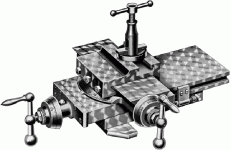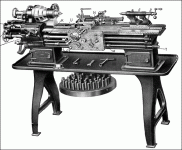The pattern shown in the picture is sometimes called "engine turning". It was also known as an "apprentice finish". This latter was a somewhat derisive term used by old-timers to describe efforts by apprentices to 'dress up' what might be mediocre work.
To support what Billtodd posted: I learned to make the 'engine turned finish' when I was a teenager. We used a hardwood dowel chucked in a drill press, or a piece of aluminum or yellow brass rod, charged with lapping compound. This produced polished circles. The trick was to get a uniform pattern of overlapped polished circles. I remember once, finishing up a job in the form of a piece of tooling to be used in a machine shop where I was working. I thought I was hot stuff, finishing it by drawfiling, breaking all the sharp edges with a neat small filed chamfer, and then polishing with emery cloth wrapped on my file. I should have stopped there. Instead, I engine turned the outer surfaces. I caught hell for it. The older journeymen and the foreman hollered that I was working in a machine shop, not a "Canal Street jeweler's" (jewelers along NYC's Canal Street were not held in the highest regard, to be polite). They were also annoyed that I had spent shop time putting on that engine turned finish, and let me know about that as well. I will admit to occasionally putting the engine turned finish on some jobs coming out of my own shop, using an aluminum rod as the lap and "Clover" lapping compound. The 'plates' in some pocket watch movements were also finished by 'jewelling', and maybe that is where the term 'jewelling' for this type of finish comes from.
A closer look at the picture of the compound slide shows this 'engine turned finish' is applied to non-bearing surfaces, rather than to the actual sliding/contact surfaces.
I recall gunsmiths as well as firearms manufacturers would sometimes offer what they called a "jewelled finish" on rifle bolts. This was an engine turned finish done with a very small diameter lap. Another example would be the aluminum cowling on Lindbergh's plane "The Spirit of St Louis", as well as automobile instrument panels in the 30's. On aluminum, this finish can be gotten using a fine wire brush chucked in a drill press, and nowadays, is often done on aluminum using a die grinder with "Scotchbrite" discs.











